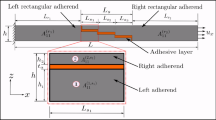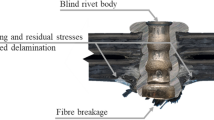Abstract
The effect of z-pin surface treatment on the delamination fracture properties of z-pinned unidirectional carbon fibre/epoxy prepreg laminate is presented in this paper. Cryogenic and plasma treatments were used to increase the pin/composite interface properties. Z-pin pullout tests were carried out to study the relations between the bridging force and the displacement. Mode-I double-cantilever beam tests were used to characterize the improvements in delamination toughness. It was pointed out that appropriate treatments could effectively increase the delamination fracture properties. Oxygen-containing functional groups could be induced on the pin surface through cold plasma treatment. An increasing surface energy is improving the wettability so that more chemical reactions can be generated between the epoxy group and z-pin surface. Furthermore, the surface roughness of z-pins can be extended with a plasma or cryogenic treatment. The pins obtained a larger surface area, which could wet by the epoxy matrix during the z-pin-insertion and curing process.










Similar content being viewed by others
References
Mouritz AP, Cox BN (2010) A mechanistic interpretation of the comparative in-plane mechanical properties of 3D woven, stitched and pinned composites. Compos Part A 41(6):709–728
Mouritz AP, Bannister MK, Falzon PJ, Leong KH (1999) Review of applications for advanced three-dimensional fibre textile composites. Compos Part A 30(12):1445–1461
Tong Liyong, Mouritz Adrian P, Bannister Michael K (2002) 3D fibre reinforced polymer composites. 1. Elsevier, Boston
Mouritz AP (2007) Review of z-pinned composite laminates. Compos Part A 38(12):2383–2397
Partridge Ivana K, Cartié DDR, Bonnington T (2003) Manufacture and performance of z-pinned composites. Shonaike Gabriel O (Hrsg.), Advani Suresh G (Hrsg.): Advanced polymeric materials: Structure property relationships. Boca Raton and FL : CRC Press, 2003. -ISBN 978-1-58716-047-9
O’Brien TK, Krueger Ronald (2006) Influence of compression and shear on the strength of composite laminates with z-pinned reinforcement. Appl Compos Mater 13(3):173–189
Mouritz AP (2007) Compression properties of z-pinned composite laminates. Compos Sci Technol 67(15-16):3110–3120
Chang P, Mouritz AP, Cox BN (2006) Properties and failure mechanisms of z-pinned laminates in monotonic and cyclic tension. Compos Part A 37(10):1501–1513
Sweeting RD, Thomson RS (2004) The effect of thermal mismatch on Z-pinned laminated composite structures. In: Composite Structures 66(1–4):189–195. -ISSN 0263-8223. -Twelfth International Conference on Composite Structures
Chang P, Mouritz AP, Cox BN (2007) Flexural properties of z-pinned laminates. Compos Part A 38(2):244–251
Zhang X, Hounslow L, Grassi M (2006) Improvement of low-velocity impact and compression-after-impact performance by z-fibre pinning. Compos Sci Technol 66(15):2785–2794
Cartié DDR, Cox BN, Fleck NA (2004) Mechanisms of crack bridging by composite and metallic rods. Compos Part A 35(11):1325–1336
Dai SC, Yan W, Liu HY, Mai YW (2004) Experimental study on z-pin bridging law by pullout test. Compos Sci Technol 64(16):2451–2457
Vazquez JT, Castanié B, Barrau JJ, Swiergiel N (2011) Multi-level analysis of low-cost z-pinned composite joints: part 1: single z-pin behaviour. Compos Part A 42(12):2070–2081
Zhang H, Zhang Z, Breidt C (2004) Comparison of short carbon fibre surface treatments on epoxy composites: I. Enhancement of the mechanical properties. Compos Sci Technol 64(13-14):2021–2029
Rashkovan IA, Korabelnikov Yu G (1997) The effect of fiber surface treatment on its strength and adhesion to the matrix. Compos Sci Technol 57(8):1017–1022
Brandl W, Marginean G, Chirila V, Warschewski W (2004) Production and characterisation of vapour grown carbon fiber/polypropylene composites. Carbon 42(1):5–9
Li Hao, Liang Hui, He Fang, Huang Yuan, Wan Yizao (2009) Air dielectric barrier discharges plasma surface treatment of three-dimensional braided carbon fiber reinforced epoxy composites. Surf Coat Technol 203(10-11):1317–1321
Li Rongzhi, Ye Lin, Mai Yiu-Wing (1997) Application of plasma technologies in fibre-reinforced polymer composites: a review of recent developments. Compos Part A 28(1):73–86
Wilhelmy L (1863) Über die Abhängigkeit der Capillaritäts-Constanten des Alkohols von Substanz und Gestalt des benetzten festen Körpers. In: Poggendorf JC (Hrsg.) Annalen der Physik und Chemie Bd. 119. Verlag von Johann Ambrosius, 1863, S. 177–217
Chang P (2006) The mechanical properties and failure mechanisms of z-pinned composites, Royal Melbourne Institute of Technology, Ph.D. Thesis
Cartié DDR (2000) Effects of z-fibres™ on the delamination behaviour of carbon fibre/epoxy laminates, Cranfield University, Ph.D. Thesis
Partridge Ivana K, Cartié DDR (2005) Delamination resistant laminates by Z-Fiber\(\circledR\) pinning: Part I manufacture and fracture performance. Compos Part A 36(1):55–64
Kaelble DH (1670) Dispersion-polar surface tension properties of organic solids. J Adhesion 2(2):66–81
Owens DK, Wendt RC (1969) Estimation of the surface free energy of polymers. J Appl Polym Sci 13(8):1741–1747
Liu HY, Yan W, Mai YW (2003) Z-pin bridging force in composite delamination. In: Blackman BRK (Hrsg.), Pavan A (Hrsg.), Williams JG (Hrsg.): Fracture of Polymers, Composites and Adhesives II Bd. 32. Elsevier, 2003. - ISSN 1566-1369, S. 491–502
Robinson P, Das S (2004) Mode I DCB testing of composite laminates reinforced with z-direction pins: a simple model for the investigation of data reduction strategies. Eng Fract Mech 71(3):345–364
ISO Standard [15024:2001]: Fibre-reinforced plastic composites–determination of mode I interlaminar fracture toughness, GIC, for unidirectionally reinforced materials.
Author information
Authors and Affiliations
Corresponding author
Rights and permissions
About this article
Cite this article
Knopp, A., Scharr, G. Effect of z-pin surface treatment on delamination and debonding properties of z-pinned composite laminates. J Mater Sci 49, 1674–1683 (2014). https://doi.org/10.1007/s10853-013-7851-2
Received:
Accepted:
Published:
Issue Date:
DOI: https://doi.org/10.1007/s10853-013-7851-2




